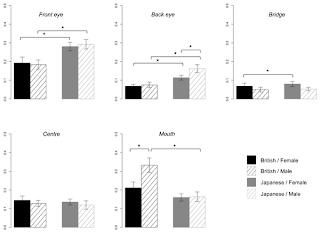;+front+eye,+back+eye,+bridge,+centre+and+mouth..png) |
| Examples of the area of interest (AOI); front eye, back eye, bridge, centre and mouth. (Credit: Senju et al.,/PLoS ONE) |
Main Point:
Different cultures have difference in patterns of face scanning even in the first years of life.
Published in:
PLoS ONE
Study Further:
Face scanning behavior:
Newborns have the ability to look at the faces particularly those looking directly to them. According to different studies, it has been found that infants start adult-like face scanning behavior, such as looking and concentrating at mouth and eyes, even at the age of 6 weeks.
Previously, researchers worked on Western European (British) and Eastern Asian (mainly Chinese) adults, and found that Western European participants concentrate on both the eyes and the mouth while Eastern Asian participants concentrate more on the centre of the face. The same phenomenon was found in young infants from these nations.
In other studies, researchers reported more fixation of British participants on the mouth area while more fixation of Japanese participants on the eyes. They also found that British participants were less affected by gaze shift (movement of eyes) than Japanese participants.
In another study, it has been found that males are more strongly manifested by the cultural norms of face and gaze pattern than females.
Present Research:
Researchers, in the present study, worked on British and Japanese children in the age range 1-7 and found that British children concentrate more on mouth while Japanese children concentrate more on eyes; the same finding as for adults.
This research clearly showed that the people from different cultures have differences in their face scanning patterns.
Researchers have also reported that the younger male children and the older female children showed more exaggerated patterns of culture-specific face gaze.
This research is also showing that the people from different cultures used different patterns to study emotions of the other people.
“These results highlight the new frontier of the research about how cultural norms can affect the development of social cognition and behaviour, which would provide a great opportunity to study the effect of postnatal environment on human behavioural and cognitive development,” Researchers wrote.
 |
| Relative visit duration on each AOI during the entire period of stimulus presentation, for each cultural background and gender of the participants (Credit: Senju et al.,/PLoS ONE) |
Research suggestions:
Researchers have found atypical patterns of face scanning behavior in some neurodevelopmental disorders, such as autism spectrum disorders (ASD). Mechanism behind the atypical face scanning patterns in ASD is not clear. You can work on this mechanism.
Further studies are required to check the cultural norms of face gazing in males and females. Moreover, the development of culture-specific pattern of face gazing over the course of time has to be worked further.
Reference:
Senju A, Vernetti A, Kikuchi Y, Akechi H, Hasegawa T (2013). Cultural Modulation of Face and Gaze Scanning in Young Children. PLoS ONE DOI: 10.1371/journal.pone.0074017
No comments:
Post a Comment